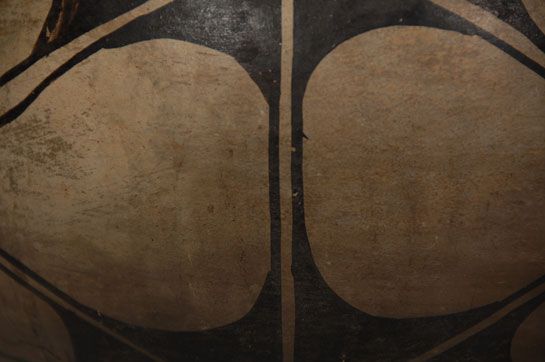Kewa Pueblo Globular Polychrome OLLA [SOLD]
+ Add to my watchlist Forward to Friend
- Category: Historic
- Origin: KEWA, Santo Domingo Pueblo
- Medium: clay, pigment
- Size: 9-3/4” tall x 11-1/4” diameter
- Item # C3753.02 SOLD
Today, we routinely accept painted pueblo pottery as the standard style that has existed forever, but, according to Dr. J. J. Brody, painted pottery only appeared about 1500 years ago. Before that time, all pottery was unpainted and totally utilitarian. Brody further states that Kewa and Cochiti painted wares more resemble eighteenth- and nineteenth-century Tewa pottery more so than that of other Keresan-speaking pueblos (Santa Ana, Zia, Laguna and Acoma), of which these two belong.
Over time, each of these six pueblos has developed its own unique painting style. Kewa Pueblo potters developed a design style based on geometric shapes—circles, triangles, and rectangles. Kewa potters also used a much stronger black paint than appears at the other pueblos.
This olla is a fine example of an excellent Kewa product. The vessel shape is globular rather than the more straight-sided jars one normally sees. Such a vessel shape provided the artist with a larger canvas on which to design. Visually, all artists must conceive of placing a two-dimensional design over a three-dimensional surface. This is more difficult than using a paint brush to place a design on a flat surface. Once the background cream-colored bentonite slip is placed on the vessel, it cannot be touched by hand or the result will be finger prints or hand prints on the surface after the jar is fired. Visualize, if you will, how you would handle the jar while painting the design on the surface without letting your hands touch the vessel.
The neck design consists of black triangles face-to-face, resulting in a cream design resembling a leaf. Although the potter painted the black triangles, it is the unpainted cream element that surfaces as a design. The same is true on the body of the vessel. By painting the corners of the crossed parallel lines, one then sees four ovoid elements emerging as the design although they technically are the background.
Condition: the jar is in very good condition. There are a couple of cracks on the underside and near the base that should and will be stabilized. There is a significant amount of residue on the interior of the jar from its having been used for some purpose. We have not attempted to clean out the interior as we feel that is part of the wonderful history of the jar.
Provenance: from a collector of pueblo pottery in Santa Fe
Recommended Reading: A River Apart: The Pottery of Cochiti & Santo Domingo Pueblos, edited by Valerie K. Verzuh

- Category: Historic
- Origin: KEWA, Santo Domingo Pueblo
- Medium: clay, pigment
- Size: 9-3/4” tall x 11-1/4” diameter
- Item # C3753.02 SOLD



